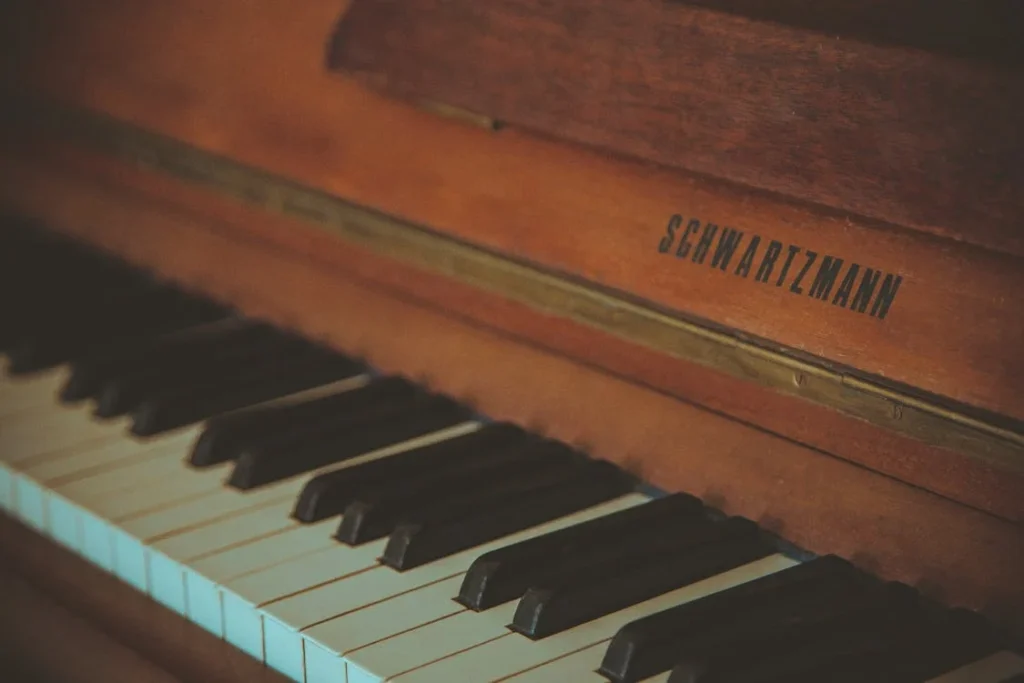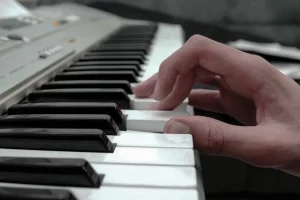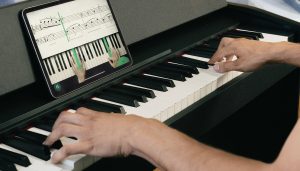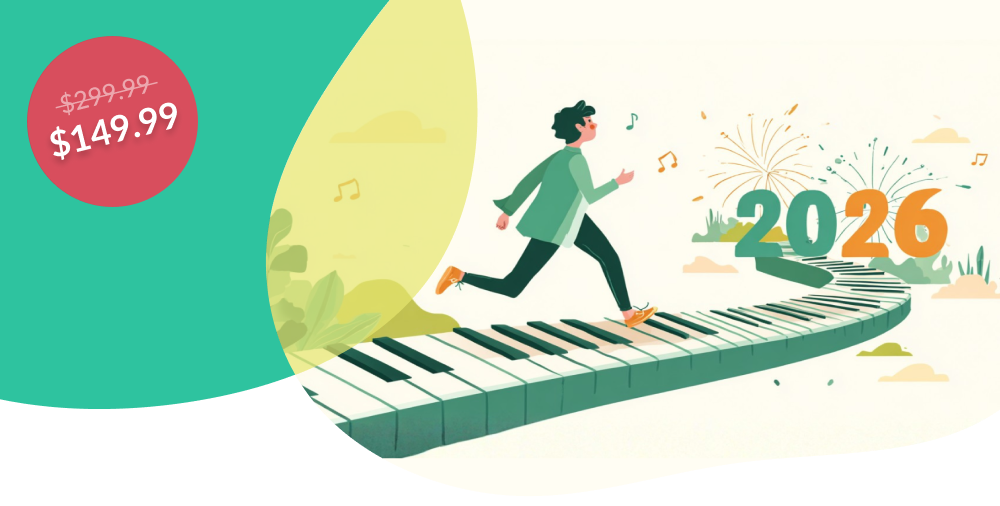Rubato is a subtle and powerful technique in music. Derived from the Italian work rubare meaning “to steal”, rubato is an expressive technique where musicians deviate from the strict timing of a piece, creating a more emotional interpretation.
Rubato has been a cornerstone of musical expression since at least the Romantic era and is essential for any pianist looking to bring more depth and nuance to their piano playing, let alone convincingly perform any music from the Romantic era or later.
In this article, we will explore rubato in piano music, take a look at how we can apply this technique to our own playing today, and look at some practical tips for mastering and refining the technique.
- Fall in love with the music - Learn your favorite songs, at a level suitable for you.
- Enjoy interactive piano lessons - Explore courses covering music theory, technique chords & more.
- Get real-time feedback - Skoove's feedback tells you what went well and what needs practice.

What is rubato in music?
Rubato in music refers to the expressive manipulation of tempo within a musical phrase. Unlike rigid adherence to the beat, rubato allows performers to introduce slight variations in timing, often speeding up or slowing down to emphasize certain notes or phrases.
Rubato is commonly used in genres such as Romantic and Classical piano music, where emotional expression and nuance are paramount. It allows performers to convey a deeper connection to the music, often reflecting the emotional content or narrative underlying the piece.
Types of rubato
There are two primary types of rubato: tempo rubato and rhythmic rubato.
In tempo rubato, the overall tempo of the piece fluctuates, with certain passages played faster and others slower. This type of rubato often involves a “give and take” approach, where the performer accelerates or decelerates the tempo for expressive purposes but ensures that the piece’s overall pacing remains balanced. Tempo rubato is particularly effective in sections of music that are lyrical or emotive, allowing the performer to highlight moments of tension or release.
Rhythmic rubato, on the other hand, focuses on the timing of individual notes or beats rather than the overall tempo. This involves slight alterations in the duration of specific notes or beats within a measure, creating a more nuanced and detailed expression.
Rhythmic rubato requires a sophisticated sense of timing and is often used in passages that demand intricate phrasing and articulation. Unlike tempo rubato, rhythmic rubato does not necessarily change the overall speed of the piece but instead adds a layer of expressive detail to the rhythm.
How rubato enhances musical expression and emotion
Rubato is often likened to the art of storytelling in music. By manipulating time, performers can emphasize certain phrases, create suspense, and convey a wide range of emotions. For instance, a pianist might use rubato to draw out a particularly poignant melody in a wedding piano song, giving the listener time to absorb the emotional weight of the moment.
Conversely, quickening the tempo can heighten a sense of urgency or excitement in a video game piano song. This expressive freedom lets performers personalize their interpretation, making the music more engaging and relatable. The use of rubato is not merely technical; it is deeply intertwined with the performer’s emotional response to the music, making it a vital tool for musical storytelling.
Rubato in piano playing
Playing rubato on the piano involves combining technical skill and expressive intuition. Pianists must be attuned to the music’s natural ebb and flow, allowing them to make subtle adjustments to timing and rhythm. Let’s check out some key techniques for incorporating rubato into piano playing.
One of the most effective ways to learn rubato is by listening to trying pinao recordings of master pianists and mimicking their use of the technique. This practice helps pianists internalize the subtle nuances of rubato, including when and how to apply it.
Just as singers use breath to shape phrases, pianists can imagine “breathing” with the music. This mental approach helps create natural pauses and emphasis, facilitating a more fluid and expressive use of rubato.
While a metronome is invaluable for developing a strong sense of rhythm, practicing without it allows pianists to explore the expressive possibilities of rubato. Alternating between these approaches helps balance rhythmic precision with expressive freedom.
Effective rubato often involves nuanced phrasing and dynamic control. Pianists should practice shaping phrases and varying dynamics to highlight key moments in the music, using rubato to enhance these expressive elements no matter if you are playing anime piano music or some other genre.
Additionally, practicing with a metronome at various tempos was recommended to help internalize the rhythmic structure and improve the expressive use of rubato in performances. One of the secrets to playing Rubato is not overdoing it. This video by Robert Estrin gives a closer glimpse of what it is like to play Rubato like an expert.
Examples of rubato in famous piano pieces
Rubato is prominently featured in the works of many renowned composers, particularly in the Romantic period. For instance, Frédéric Chopin’s Nocturnes are often cited as quintessential examples of rubato music. In these pieces, the expressive use of tempo fluctuations is crucial for conveying the lyrical and emotional character of the music.
Similarly, Franz Liszt’s “Liebestraum” (Dreams of Love) showcases dramatic shifts in tempo that enhance the piece’s romantic and evocative qualities. Another notable example is Ludwig van Beethoven’s “Moonlight Sonata,” particularly in the first movement, where subtle use of rubato adds to the piece’s mysterious and introspective mood. These works demonstrate how rubato can transform a performance, adding layers of meaning and expression that go beyond the notes themselves.
The role of phrasing and dynamics in rubato
Phrasing and dynamics are integral to the effective use of rubato, as they help shape the music’s narrative and emotional arc. Phrasing refers to how musical sentences are structured and articulated, guiding the listener through the piece. In rubato, phrasing often dictates where and how to apply tempo changes, ensuring they feel natural and purposeful.
Dynamics, or the varying levels of loudness and softness, interact with rubato to underscore emotional contrasts. For example, a pianist might use a gentle rubato combined with a soft dynamic to express tenderness or a more pronounced rubato with a forte dynamic to convey passion or intensity. Together, these elements create a cohesive and compelling musical performance.
Common Misconceptions and Pitfalls
A common misunderstanding about rubato is that it allows for arbitrary or excessive deviations from the score. However, rubato should be applied with care and respect for the composer’s intentions. It is not a license to disregard the structure or rhythm of the piece entirely but rather a tool to enhance its expressive qualities. For example, rubato is not commonly used in stride piano.
The balance between freedom and structure
One of the greatest challenges in using rubato is finding the right balance between expressive freedom and structural integrity. While rubato allows for personal interpretation, it must not disrupt the overall flow or coherence of the piece.
Pianists must maintain a clear sense of the underlying pulse, even as they stretch or compress time within phrases. This balance is crucial for ensuring that rubato enhances the performance rather than detracting from it. Effective use of rubato requires both a disciplined approach to timing and a willingness to explore emotional expression, making it a sophisticated and nuanced aspect of piano playing.
Learning rubato with Skoove
If you are a pianist who wants to refine your rubato technique, Skoove is an invaluable resource. Skoove is an online piano learning platform that provides interactive lessons, covering a wide range of topics, including expressive techniques like rubato.
One of Skoove’s key features is its real-time feedback system, which helps users fine-tune their timing and phrasing, making it easier to master the subtle nuances of rubato. The platform offers a comprehensive library of pieces, each accompanied by detailed guidance on incorporating rubato, allowing users to practice and experiment within a structured learning environment.
Skoove’s lessons are designed to cater to various skill levels, from beginners to advanced players, making it accessible to anyone looking to improve their piano playing.
Additionally, the platform’s emphasis on emotional connection and musical storytelling aligns perfectly with rubato’s expressive nature, helping pianists develop a deeper understanding and appreciation of this technique.
By using Skoove, pianists can gain the skills and confidence needed to apply rubato effectively, enhancing their overall musicality and performance.
Make your music more dramatic with rubato
Rubato is an expressive tool that adds depth, nuance, and emotion to your piano playing. Learning how to play rubato convincingly is a requirement for many pieces from the classical repertoire. Additionally, with rubato you can heighten the emotional power and make your performance more engaging for your audience.
Whether you are a beginner or an advanced player, understanding and practicing rubato can elevate your musical interpretation, allowing you to connect more deeply with the music and your audience. Resources like Skoove offer invaluable support in this journey, providing structured lessons and real-time feedback to help you refine your skills.
Author of this blog post:
Susana Pérez Posada

With over seven years of piano education and a deep passion for music therapy, Susana brings a unique blend of expertise to Skoove. A graduate in Music Therapy from SRH Hochschule Heidelberg and an experienced classical pianist from Universidad EAFIT, she infuses her teaching with a holistic approach that transcends traditional piano lessons. Susana’s writings for Skoove combine her rich musical knowledge with engaging storytelling, enriching the learning experience for pianists of all levels. Away from the piano, she loves exploring new places and immersing herself in a good book, believing these diverse experiences enhance her creative teaching style.
Published by Lydia Ogn from the Skoove team















